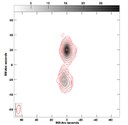VLBA Images HI Clouds at z = 0.123
 Using long-slit optical spectra obtained with the 2-m telescope at IUCAA Girawali Observatory, the authors show that the radio source J094221.98+062335.2 (z = 0.123) is associated with a galaxy pair undergoing a major merger. Its companion is a normal star-forming galaxy infalling with a velocity of 185 km s−1at a projected separation of 4.8 kpc. Using the Westerbork Synthesis Radio Telescope (WSRT) and Giant Metrewave Radio Telescope (GMRT), Srianand et al detect a strong H I 21 cm absorption at the systemic redshift of the radio galaxy with N(HI) ∼ 9 × 1021 cm−2. Such a strong HI 21 cm absorption is rare and has been seen only in a few compact radio sources associated with similar merging galaxy pairs.
Using long-slit optical spectra obtained with the 2-m telescope at IUCAA Girawali Observatory, the authors show that the radio source J094221.98+062335.2 (z = 0.123) is associated with a galaxy pair undergoing a major merger. Its companion is a normal star-forming galaxy infalling with a velocity of 185 km s−1at a projected separation of 4.8 kpc. Using the Westerbork Synthesis Radio Telescope (WSRT) and Giant Metrewave Radio Telescope (GMRT), Srianand et al detect a strong H I 21 cm absorption at the systemic redshift of the radio galaxy with N(HI) ∼ 9 × 1021 cm−2. Such a strong HI 21 cm absorption is rare and has been seen only in a few compact radio sources associated with similar merging galaxy pairs.
Milliarcsecond resolution VLBA observations resolve the radio source into a compact symmetric object with the hotspot separation of 89 pc. The 21 cm absorption is detected in the VLBA spectra towards both the radio lobes, albeit with a strong optical depth gradient. The strong 21 cm absorption is consistent with it being arising from a clumpy circum-nuclear disc/torus. Two weaker absorption lines were also detected redshifted with respect to the radio source in the WSRT/GMRT spectrum. They probably represent cold (i.e. T ≤ 104 K) H I gas falling into the radio source. The presence of high concentration of H I gas in the circum-nuclear regions and signature of infalling cold gas suggests that the young radio source may have been triggered by the gas infall due to the ongoing merger.
View Paper: Circumnuclear and infalling H I gas in a merging galaxy pair at z = 0.123, R. Srianand (IUCAA), N. Gupta (IUCAA), E. Momjian (NRAO), and M. Vivek (Utah), 2015 MNRAS, 451, 917 (1 June 2015).




Connect with NRAO